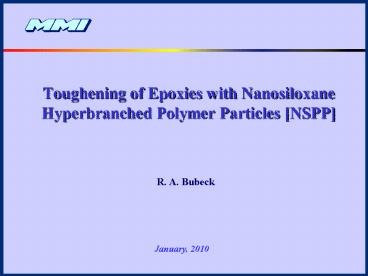Toughening of Epoxies with Nanosiloxane Hyperbranched Polymer Particles [NSPP] - PowerPoint PPT Presentation
1 / 9
Title:
Toughening of Epoxies with Nanosiloxane Hyperbranched Polymer Particles [NSPP]
Description:
Early target was in Naval and pleasure craft applications * Replacement of vinyl ester resins with epoxy composite to ... upon curing agent. Low ... – PowerPoint PPT presentation
Number of Views:203
Avg rating:3.0/5.0
Title: Toughening of Epoxies with Nanosiloxane Hyperbranched Polymer Particles [NSPP]
1
Toughening of Epoxies with Nanosiloxane
Hyperbranched Polymer Particles NSPP
- R. A. Bubeck
January, 2010
2
Project Motivation
The continued growth in large composite
structures will require improved performance in
resistance to cracking, impact and
fatigue. UNMET NEED superior epoxy resin with
improved toughness Toughening agents
need to have improved processibility and
thermal stability. Development of structural
composites and adhesives for
more demanding applications. Early target was
in Naval and pleasure craft applications
Replacement of vinyl ester resins with epoxy
composite to improve long term
performance i.e., stress due to shrinkage and
poor adhesion to glass and carbon fiber. Current
target is in the manufacture of wind turbine
blades and rotors for larger turbine generators
2.5 up to 5 MWh.
3
Introduction
Picture of the Wind Farm, Palm Springs,
California. This wind farm on the San Gorgonio
Mountain Pass in the San Bernadino Mountains
contains more than 4000 separate windmills and
provides enough electricity to power Palm Springs
and the entire Coachella Valley.
4
Introduction
Fabrication by VARTM (Vacuum Assisted Resin
Transfer Molding), SCRIMP (Seemans Composite
Resin Infusion Molding Process) Resin Transfer
Molding (RTM), Pultrusion applicable Resin flow
with toughening additive must flow freely through
the fiber weave in order to maintain uniform
distribution of toughening agent. CTBN, the most
common toughening agent is, filtered out by the
fiber mat. Nanosiloxane Hyperbranched Polymer
Particles (NSPP) yield an even distribution of a
thermally stable toughener
5
VARTM Process
The VARTM process for the fabrication of a wind
turbine blade surface.
After -- M. S. Koefoed, Modeling and Simulation
of the VARTM Process for Wind Turbine Blades
Ph.D. Dissertation, Institute of Mechanical
Engineering, Aalborg University, Denmark, January
2003.
6
Preparation of NSPPs
Summary of Reactions
7
TEM of NSPP Particles in D.E.R. 332/Ancamine
2049Cured Casting at 5 wt. Additive
300 nm
8
Toughening Additives and Mechanical Properties
DER 332 DER332/CTBN1 DER332/ 5 wt NSPP DER332/ 10 wt NSPP DER332/ 10 wt NSPP/CTBN
Viscosity (cP) 4,500 10,500 2,000 2,000 ND
Unnotched Izod (ft lb/in) 3.3 4.1 4.7 5.1 11.5
Tensile strength (psi) 12,900 12,200 8,700 8,400 ND
Tensile modulus (Ksi) 376 322 364 352 ND
- Additives present at 5 wt (except where noted)
and treated with Ancamine 2049, 32.4 phr - CTBN carboxy-terminated butadiene acrylonitrile
rubber - NSPP nanosiloxane hyperbranched polymer
particle - NSPP/CTBN, 5 wt NSPP and 5 wt CTBN
- ND Not Determined
9
Attributes
- Well-defined particles formed during cure of
Epoxy - Tuning with size modality.
- Size 300 nm after cure depending upon curing
agent. - Low elastomer Tg i.e., siloxanes _at_ - 60C.
- NSPP additives are soluble in and significantly
decrease the viscosity of epoxies before cure
unique property. - Toughness comparable to other nanoparticles.
- Thermal stability 200C.
- Scalable to multiple hundreds of pounds.
- Modifier costs (est. 16 30/lb).































